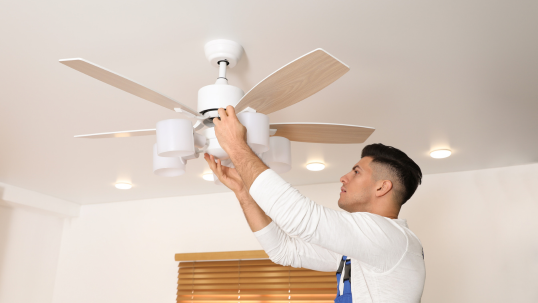Common Ceiling Fan Sizes And Maintenance Tips
There are few items that are as simple or stylish as the ceiling fan when it comes to improving comfort and lowering energy consumption at home. As more homeowners look to keep heating and cooling bills in check, new ceiling fan installations are skyrocketing in the Greenville area. In our guide, you’ll learn how to size and maintain a ceiling fan for any room in your home.
How to Size A Ceiling Fan for Optimal Performance
Selecting the right size ceiling fan improves efficiency and circulates just the right amount of air. Sizing your fan depends on the square footage of the room you’re installing your fan in, which dictates the blade diameter.
Check out these recommendations from ENERGY STAR:
- Small rooms (less than 100 square feet): 29-36 inches in diameter
- Medium-to-large rooms (up to 400 square feet): 36-50 inches in diameter
- Large rooms (over 400 square feet): 50-70 inches in diameter
Why Ceiling Fan Size Matters
Bigger isn’t always better. Homeowners should lean toward smaller fans if their room is right on the 400-square-foot threshold for a few reasons:
- A ceiling fan that is too big may be visually or physically overwhelming and inefficient
- If it’s too powerful, a ceiling fan can make the space feel like the center of a tornado
However, a ceiling fan that is too small won’t circulate air efficiently, limiting its effectiveness. Your Five Star Air Conditioning Heating Plumbing Electrical technician will help determine your space's ideal ceiling fan size. To make the most of your new fan, read on for recommendations.

The Most Common Types of Ceiling Fans
Standard/Downrod Mount Ceiling Fans
This is the most common type of fan found in homes. This type of ceiling fan hangs from a downrod, which positions the fan away from the ceiling to optimize airflow. The length of the downrod is adjustable on most models.
Flush Mount Ceiling Fans
Ideal for rooms with low ceilings, flush mount ceiling fans install directly against the ceiling to maximize headroom.
Styles of Ceiling Fans
Stylistically, ceiling fans are usually categorized as traditional, modern, rustic, or industrial. Ceiling fans are versatile because they can be the centerpiece of a space with bold styling, or a neutral component with muted colors, making selection fun for the design-minded.
Once you’ve found the perfect fit, let us handle the hard part. For ceiling fan wiring or to install a new switch for your fan, contact our experienced team today!
Your Ceiling Fan Maintenance Checklist
Ceiling fans do need maintenance, but not much! Most of it is cleaning the blades and ensuring the motor and mounts work properly. Follow these ceiling fan maintenance tips and stay ahead of potential issues and ceiling fan repairs.
Remember, safety first—always turn off the fan before cleaning or adjusting your fan.
Read more: Top Tips To Improve Home Energy Efficiency
Clean Your Ceiling Fan: Every 1-3 Months
Wiping down fan blades every one to three months removes dust buildup. Use a microfiber cloth to wipe the top and bottom of the blade. Some homeowners also use a pillowcase—you can wrap the blade to remove dust and trap it inside.
Make sure to clean the light, too, if your fan has one.
Semi-Annual Tune-Ups: Every 6-12 Months
Consider giving your fan a quick tune-up every spring or fall, especially when you change its direction.
- Tighten all screws on the fan blades, motor housing, and mounting bracket.
- Visually inspect the ceiling fan wiring for signs of damage or exposure.
- Replace the batteries in the wireless remote (if it’s been a while).
- Lubricate, if necessary. Older fans have oil ports and usually call for non-detergent oils like SAE 10W or SAE 20W. New fans do not require lubrication. Since there are many different types of ceiling fans, check your owner’s manual for model-specific instructions.
What Direction Should a Ceiling Fan Go In the Winter?
Get the most out of your ceiling fan by changing its rotation direction seasonally. Most units have a simple toggle switch to change direction, though some require a screwdriver.
- The ceiling fan direction for winter is clockwise. Warm air rises, which means heat tends to gather near the ceiling. A clockwise-spinning fan pulls cooler air up, forcing warm air down along the walls and back into the center of the room.
- The ceiling fan direction for summer is counterclockwise. A counterclockwise-spinning fan pushes air downwards, creating a cool breeze and enhancing your home’s natural airflow.
Trust the Ceiling Fans Experts in Greer
From sizing and selection to wiring a ceiling fan, we’re the Greenville area’s go-to source for expert ceiling fan services. Our experienced technicians will keep your fan spinning for years to come. Count on Five Star Air Conditioning Heating Plumbing Electrical for all your home service needs!
Contact us today or call 864-306-4898 to schedule your appointment and live more comfortably in your home.

